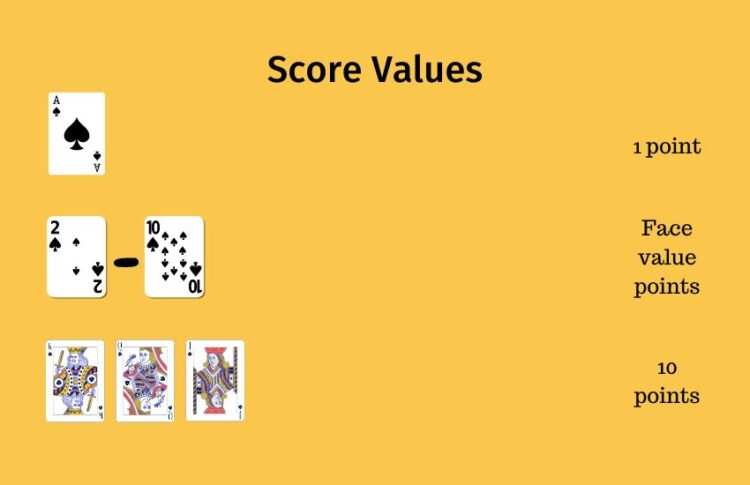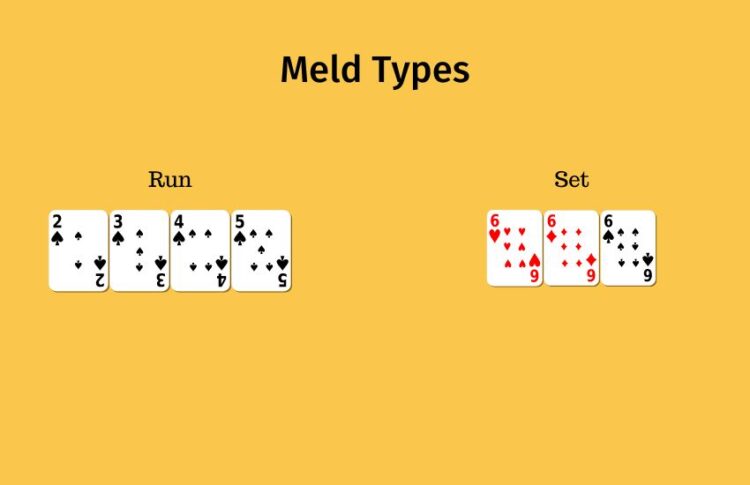
OBJECTIVE OF RUMMY: Be the first player to empty their hand and go out.
NUMBER OF PLAYERS: 2 or more players
MATERIALS OF RUMMY: A standard deck of 52 cards (or two decks if playing with a bigger group of players), a way to keep score, and a flat surface.
TYPE OF GAME: Card game
AUDIENCE: All ages
OVERVIEW OF RUMMY
The origins of Rummy are uncertain, but there are two popular theories about its history. Some claim that the Rummy rules are a descendant of a game called ‘Conquian.’ In this theory, Spanish migrants brought the game to North America. The other leading theory states that the Rummy rules originate from Asia as a descendant of Mahjong. Regardless of its origin, it remains a popular card game.
Rummy is a Rummy card game for two or more players. The game’s goal is to empty your hand first by melding and discarding cards from your hand. Below we will discuss in detail the rules and strategies for Rummy. We will go over how to setup the game, the rules of gameplay and tips on how to win more consistently, and finally how to tally your score at the end of each round of play.
SETUP FOR RUMMY
The first dealer is chosen randomly and passes to the left for each new deal. The dealer shuffles the deck, and deals each player their hand of cards one card at a time.
In a 2-player game, the dealer deals a 10-card hand. In a three or 4-player game, the dealer deals a 7-card hand, and in a five or more, player game, the dealer deals a 6-card hand.
After the cards are dealt, the dealer will place all non-dealt cards centrally facedown as a stockpile.
CARD RANKING AND VALUES
The ranking for this game is King (high), Queen, Jack, 10, 9, 8, 7, 6, 5, 4, 3, 2, Ace (low). In most games, an ace can be high or low in rank but cannot bridge king to 2.
During scoring, players will pay out points based on the cards remaining in their hands. Cards 2 through 10 have their numeric value of points, and face cards are worth 10 points each. Aces are worth only 1 point. Wilds are optional, but if used during the game, they are worth 15 points.

HOW TO PLAY RUMMY
The game starts with the player to the left of the dealer. On your turn, you may draw either the top card from the facedown stockpile or the top card from the face-up discard pile. Either way, the card is added to the your hand.
You may then choose to place any melds they have in hand onto the table, or if you have previously played a meld of your own, you may also add to other players’ melds. A meld can consist of either 3 or 4 cards all of the same rank or three or more cards of the same suit in ranking order.
For example, a player draws from the top of the stockpile and now has the 4 of diamonds, the 5 of diamonds, and the 6 of diamonds in hand. These can now be melded in front of the player.

DISCARDING
After you have played or added to melds, you will discard a card. You will also discard a card to end their turn if they cannot or wish not to play any cards from hand. You will place all discarded cards face up to the discard pile. If you previously drew the top card from the discard pile, it cannot be re-discarded this turn.
For example, a player draws the top card of the discard, which is a 7 of hearts. The player may not discard the 7 of hearts until their next turn.
Going out is when you either play or discard the last card from your hand. This action ends the game, and scoring begins.
If the stockpile is depleted before a player goes out, the next player may draw from the faceup discard pile or flip the discard pile without shuffling to form a new stockpile. The game then continues.
LAYING OFF
The ability to lay off cards becomes available once a player has placed a meld. Once you have a personal meld, you may play cards from your hand to other players’ melds. Players will keep their melded cards near them for scoring.
For example, After the player melds a set of three 5s, they can then lay off the 3 of diamonds on another players run of 4 through the 6 of diamonds. The player will place the 3 of diamonds in front of themselves.
PLAYING WITH WILD CARDS
You can add wilds to the game by denoting a rank of cards as wild or adding jokers to the deck. You can use wilds to represent any card needed to add to a meld. Once a player melds a wild, if a you have the card the joker represents, you may play it out of your hand and take the joker into your hand for later use.
For example, a player has melded a run with the 5 of spades, 6 of spades, a wild card, and the 8 of spades. Another player draws the 7 of spades and may lay that card off in front of them, and draw the wild into their hand.
END OF GAME
The player who manages to play all of their cards or discards their final card at the end of their turn wins the game!
RULES OF RUMMY: A QUICK SUMMARY
Here is a summarization of the major rules of Rummy.
- A meld must consist of either three or more cards in ranked order of the same suit or three or more cards of the same rank.
- A player may only lay off cards once they have made a personal meld.
- When a player draws from the top of the discard, the player may not discard the same card on the same turn.
- To go out, a player must play or discard their last card.
RUMMY VS GIN RUMMY
There are many differences between the standard Rummy rules and the Gin Rummy rules. Gin Rummy only plays 2 to 4 players, which is less than standard rummy rules. Additionally, Gin Rummy is an ideal game for 2 players, while rummy is best with larger groups.
While players are attempting to create melds in both games, in Gin Rummy, you do not lay down your melds. Instead, players try to create the perfect hand, consisting of only cards that the player can meld. They do not want any unmatched cards in their hand. Once a player believes they have a Gin Rummy hand, they knock. If they are right, they score; otherwise, for loose cards.
When scoring, the knocking player scores the difference between their hand and the other player’s hands. If the knocker had a perfect gin hand, then they would score extra points.
| RULES | GIN RUMMY | RUMMY |
| NUMBER OF PLAYERS | 2 TO 4 PLAYERS | 2 OR MORE PLAYERS |
| OBJECTIVES | IMPROVE YOUR HAND THROUGH THE GAME TO HAVE ONLY MELDS, AND NO UNMATCHED CARDS. | MELD RUNS AND SETS FROM YOUR HAND TO EMPTY IT AS QUICKLY AS POSSIBLE. |
| SCORING | THE WINNER WILL SCORE THE DIFFERENCE BETWEEN THEIR HANDS AND THE OPPONENTS’ HANDS. | EACH LOSING PLAYER WILL PAY THE WINNER POINTS EQUAL TO THEIR REMAINING CARDS. |
RUMMY STRATEGY
Here we will discuss some tips and strategies for have a more consistent win rate at rummy. While the game does rely on luck of the draw, a player can increase their chances by following a few simple guidelines.
BE FLEXIBLE
It may seem obvious but always go for the melds you have a better chance of completing. Going Rummy is cool, but it might ruin your chances of winning if someone goes out early. Always be flexible in which cards you will pair together, and don’t get your hopes set on any particular meld.
DRAW AND DISCARD
Players are statistically more likely to draw runs. If you are wondering which card is the best to discard, it is typically 4s.
KNOWLEDGE IS AN ADVANTAGE
Knowledge is valuable, so do not draw and directly discard; instead, let your opponents wonder about what you drew by taking it into hand and then discarding it. Always keep your eye on the discard pile; you cannot go back and look through it, so it will be up to you to remember what has been discarded. If you can pay close attention to what your opponents are collecting and discarding if you have to discard a card that is helpful for them, make sure it’s for set and not their runs.
HOW TO TALLY YOUR SCORE
After a player has gone out and the round ends, players will score for the game. Each player will pay a number of points equal to the value of cards remaining in their hand.
If a player manages to go Rummy, which means a player goes out in one turn without previously melding any cards, the other plays pay double points.
END OF GAME
The game ends when players wish it to. A game may last a certain number of deals or to a certain point value. The winner is the player with the most points.
- 12 BEST HARRY POTTER BOARD GAMES - November 16, 2023
- 50 BEST HALLOWEEN GAMES - October 4, 2023
- 50 BEST CHRISTMAS GAMES - September 13, 2023